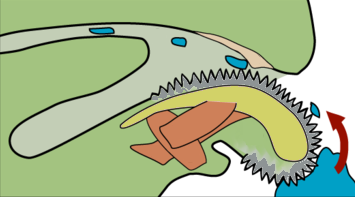Nutrition
The Polygyridae obtain their food through a radula like many other gastropods. Snails from the Polygyridae use their radula to scrape up leaf litter and in some cases they scrape of parts of young plants (Auffenberg et al, 1989). They are consuming this plant matter for the microfungi that are living on these live or decomposing plants (Auffenberg et al, 1989).
The radula is a scraping mechanism that allows these gastropods to tear chunks of this plant matter off of the plant itself or the ground and carry it up into its mouth. the radula is a tongue like appendage that is covered by a belt of hooks that curve upward (Wilber et al, 1966). These hooks catch the food and their upward curve allows them to keep the food from falling out of their mouth before it reaches the esophagus.
The gastropods digestive system is similar to ours but it does include a few additional parts. Food passes from the mouth to the esophagus. In some gastropods like the opisthobranchs and pulmonates the esophagus is dilated to form a crop that stores and digests their food (Wilber et al, 1966). Some opisthobranchs have a gizzard that separates an anterior and posterior crop (Wilber et al, 1966). These structures then lead to the stomach. After being broken down in the stomach the food passes into the intestine which passes near the kidney and runs along the right side of the mantle cavity and opens at the margin of the cavity (Wilber et al, 1966). The final portion of the intestine is called the rectum (Wilber et al, 1966). The intestine is used to consolidate the fecal matter before excretion (Wilber et al, 1966). In Daedalochila auriculata the body has undergone torsion which means that the intestine turns around and the anus is in the same area as the head. This is allows the snail to only have one opening in their shell and allows them to protect themselves better when under attack from a predator.
In Daedalochila auriculata most of these organs have elongated along with the organism itself and the shape of its shell (Pilsbry, 1930)
In molluscs numerous blind-ending tubules communicate with the stomach and aid in the digestion of the food (Wilber et al, 1966). They help elaborate enzymes, absorb, store, and excrete food as well as partake in phagocytosis (Wilber et al, 1966). These cells partake in every part of the digestive process and therefore are very important to the survival of these molluscs.
Terrestrial gastropods face an interesting dilemma when it comes to the retention of water. Many molluscs live in the sea and have a very water permeable outer layer. Terrestrial gastropods have this same layer in a habitat that is not nearly as full of water. Their skin is still water permeable so they have a big problem retaining the water that they have (Wilbur et al, 1964). This problem is solved by estivation and hibernation. The gastropods draw themselves into their shells and seal the entrance off. This way they are able to stop any water from escaping while being protected by their shell (Wilbur et al, 1964).
Gastropods have an open circulatory system. This is a very different system from our own because the blood (called hemolymph) is not always in a vein or artery. The hemolymph is pumped by a heart to the lugs (in the case of terrestrial snails) and from there it is pumped towards the organs. There it is pumped out of openings in the arteries and flows over the organs bringing them oxygen. The hemolymph then makes its way to the sinuses and is sucked up by veins which then transport it back to the heart to repeat this process.
